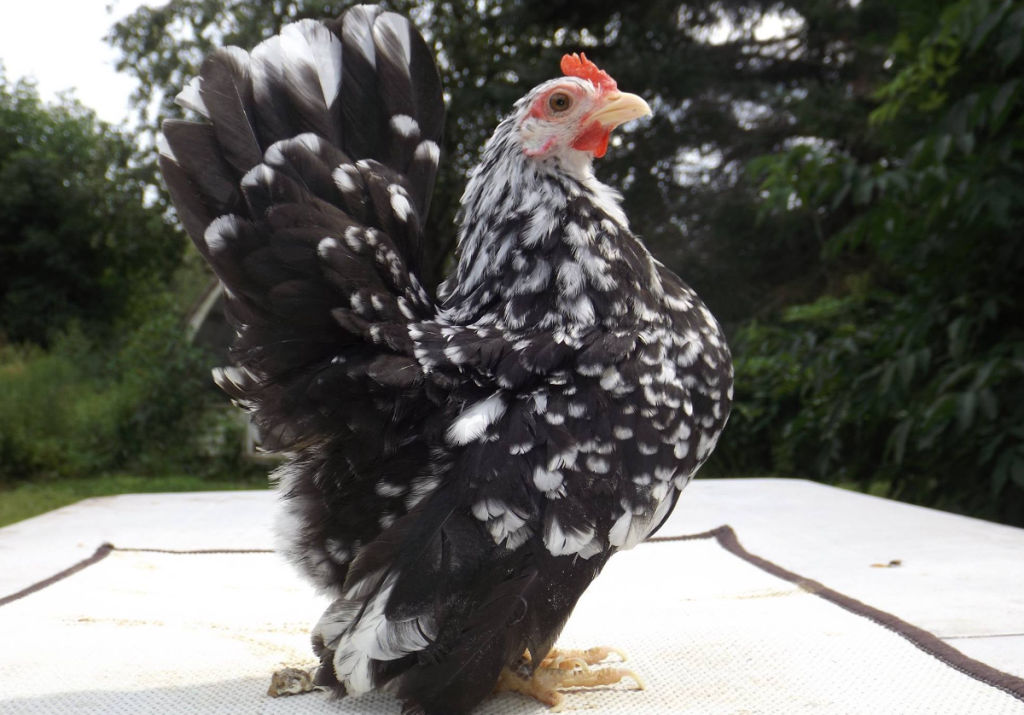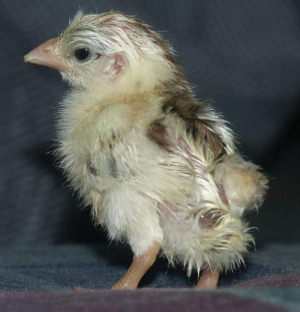Feeding Serama bantams.

What should I be feeding my Serama bantams?
Whilst the Serama is merely just a very small breed of chicken, it does require careful feeding.
Due to the very small size of the A class sized Serama, feeds designed for large breeds can be difficult for the very small Serama to eat therefore it is advisable to find a feed which consists of a small pellet or even a breeders mash or to even crush larger pelleted feeds.
Larger Serama of B sizes and above do well on a standard pellet and rarely encounter feeding problems. I personally feed breeders mash and crushed seeds as I find that their breeder pellet for bantams is just a bit big even for most adult Serama. Treats are fine for Serama chickens and there is a list of the ideal things to treat them with.
Please remember not to over feed your chickens as an over fed bird is an unhealthy bird which is unlikely to be a viable breeder and will live a short life.
Serama are not particularly predisposed to being overweight, and should have feed available throughout the day, however ample exercises is very important and should be provided regularly in the form of a large pen with perches or a run.
Below: Serama chicks need fine feed or they may struggle.

Another point to remember when feeding Serama is the feeding containers used. Bowls placed on the floor can tip up when stepped on causing leg injuries, they are also easily walked through which can contaminate food with faeces, resulting in possible illness therefore it is advisable to use a specially designed poultry feeding vessel.
Seen below is the standard d-cup feeder or drinker which securely hooks over the wire of a cage and can be situated at a height which suits your individual birds. It can be used for feed or water.
The only drawback is they will require frequent refilling if there are several birds in the pen, as well as it being likely that you will need several of these to contain enough feed or water to maintain several birds.
You can use chick feeders for adult birds or hopper style feeders. These kinds of feeders are ideal if there are several birds sharing a pen. They also make less work as they require filling less often. These are used for feed only.
Treadle feeders are useless for Serama bantam chickens, they are not heavy enough to open them.
The ideal drinker for your Serama is the fountain style drinker. These drinkers vary in size and can hold large quantities of water and offers fresh clean water rather than stagnant water as in a still drinker. These can also be refilled less frequently than cup or bowl style drinkers, although it is advisable to refresh your birds water at least once daily.
Feeding Serama chicks and growers:
Serama chicks can be extremely small, and as such they can struggle to feed on standard poultry chick crumbs. For such small chicks it is advisable to crush their chick crumbs using something similar to a pestle and mortar or even finely grind in the blender.
Do not crush into a powder as some suggest as this can result in dust inhalation and respiratory problems as food dust in the respiratory tract is a sure way to cause illness.
Not only can this method of feeding cause respiratory problems it can also cause eye infections should the chicks get it in their eyes, and also it can cause crop problems as the dust mixed with the chicks drinking water can form a sticky paste that can be difficult for the crops of young chicks to handle which may cause crop binding or sour crop.
As stated earlier, some Serama chicks can be extremely small, this can mean that they may easily fall into water or food containers resulting in them drowning or being trapped.
I use heavy glass night light holders for feeders and drinkers for very small chicks as they are too shallow for the chicks to fall into and being glass they are very heavy and stay put.
I classify my young-stock as "Growers" once they reach approx 8 weeks of age. At this stage I move them onto a grower feed which does not contain growth promoters, which are detrimental to the Serama as the breed standard states they must remain small.
Some grower pellets are available in very tiny pellets which are specifically designed for such small fancy poultry varieties. I keep my growers on this feed until they are approx 16 weeks old, I then move them onto a breeder pellet.
Always remember that when feeding your birds that the quality of feed offered directly affects the quality of the animal. A chick reared on poor quality nutrition is likely to be sickly and is likely to mature into a sickly, unproductive adult.
An adult bird that has been poorly fed from hatching will never be a strong bird and may not lead a long life, some link poor diet to infertility. Feather quality is also greatly affected by a poor diet. The quality of feed you give to your breeding birds is of ultimate importance as the quality and strength of offspring is directly affected by quality of nutrition.
Being so small the Serama does not cost a lot to feed.
Do not feed laying feed to young birds as the excess calcium can cause many problems like kidney failure. Only laying chickens need laying feed or mash.
Supplements and treats for Serama bantams:
These nutritional Supplement should maximise the health, appearance, fertility, and well being of your Malaysian Serama, and all your other poultry.
Supplements should be accurately measured and hand mixed and formulated from the best all natural ingredients. The idea is to help the nutritional well-being of each every one of your Serama. They should contain no artificial additives. Try some for 3 months or so and see whether you notice the difference in your flock.
What supplements should I use?
Diatomaceous Earth(DE) - Diatomaceous Earth is a fine substance that is the remains of tiny algae that died thousands of years ago and crystallised into a fine silica-like substance. It possesses microscopic perforations which "cut" through parasites, worms and mites, much in the same way that broken glass would affect you or me.
The DE is human safe, and pet safe, and is an excellent parasite controller but do not recommend breathing in DE as it can damage your respiratory system.
Grit - Grit is a substance that is absolutely necessary to poultry health. Since chickens do not have teeth they must grind their grain in their crop with rock or gravel provided.
Grit is 100% natural granite grit and is guaranteed not to react with any other substance your poultry might ingest. It is proven to be long lasting, and you will notice right away how your problems with crop bound birds go away.
Broken sunflower seed hearts - They must be out of the shell and broken up otherwise they are too big.
Mealworms - The odd mealworm every now and again is good for chickens as a treat.
Flax or canary seed - Flax Seed is a supplement that many people are not familiar with. However for those that try it, you will never find them without it again. Flax Seeds have an extremely high concentration of Omega 3 fatty acids which are vital for excellent feather condition. You will no longer see broken feathers, slow and improper moulting, poor feathering, and dull feathers. Your birds will be sporting glossy feathers all year round and will have softer, resilient combs, wattles and legs.
Alfalfa Forage or sprouted millet - Alfalfa forage is 100% natural, pure alfalfa, and is used as a horse supplement as well. It is rich in iron, and also increases fertility. If your birds are not getting their ration of grass, or if they are inside during the winter, you will notice an immediate change after they begin to process the nutrients found in alfalfa forage.
Oyster Shell - Another vital nutrient is the calcium contained in oyster shell. Younger hens need it to continue producing hard shelled, high quality eggs. Oyster shell builds strong bones and helps older hens produce thick shelled eggs. Especially helpful for breeding season, when you can't have thin shelled eggs in the incubator.
Seaweed or Kelp Meal for Iodine, vitamins, salt, protein, and increased fertility.
Garlic for good respiratory health.
